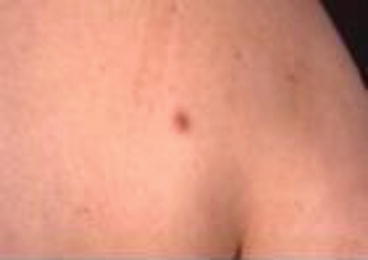Fig. 45.1
Specific lesions of sarcoidosis: Erythematous maculopapules, in a patient with cutaneous sarcoidosis, involving in a symmetrical way the upper extremities

Fig. 45.2
The same patient of Fig. 45.1. Erythematous-isolated nodule on the back, this is the first lesion appeared
If the diagnosis of sarcoidosis is strongly suspected on clinical and pathological grounds, then further investigation should be tailored to identify systemic disease and establish a baseline of disease activity. Mandatory baseline investigations should include chest X-ray, pulmonary function tests (including measurement of transfer factor), electrocardiogram, full blood count, biochemistry, serum immunoglobulins, and a 24-h urinary calcium assay. Measurement of serum angiotensin-converting enzyme (ACE), which is produced by sarcoidal granulomas, may be helpful in monitoring disease activity. It is not a particularly useful diagnostic test as levels may be raised in other conditions such as diabetes and alcoholic liver disease.
Differential Diagnosis
There is a large group of skin diseases that can enter in the differential diagnosis with cutaneous sarcoidosis manifestations, either clinically or/and pathologically. In fact cutaneous sarcoidosis is known as the “great imitator” because of its widely variable morphologies. A high index of clinical suspicion is needed to consider sarcoidosis.
Papules and maculopapules, the most common types of specific lesion, may resemble xanthelasma, acne, rosacea, syphilis, polymorphous light eruption, lupus erythematosus, adenoma sebaceum, lichen planus, syringoma, and granuloma annulare. Micropapular sarcoidosis is an unusual variant; it should be included in the differential diagnosis of lichen nitidus and lichen scrofulosorum.
Sarcoidal plaques (angiolupoid and annular plaques) may mimic lupus vulgaris, necrobiosis lipoidica, morphea, leprosy, leishmaniasis, lichen planus, nummular eczema, cutaneous T-cell lymphoma, B-cell lymphoma, Kaposi sarcoma, secondary syphilis, and gyrate erythema. Moreover, sarcoidosis may manifest as psoriasiform plaques.
Stay updated, free articles. Join our Telegram channel

Full access? Get Clinical Tree








